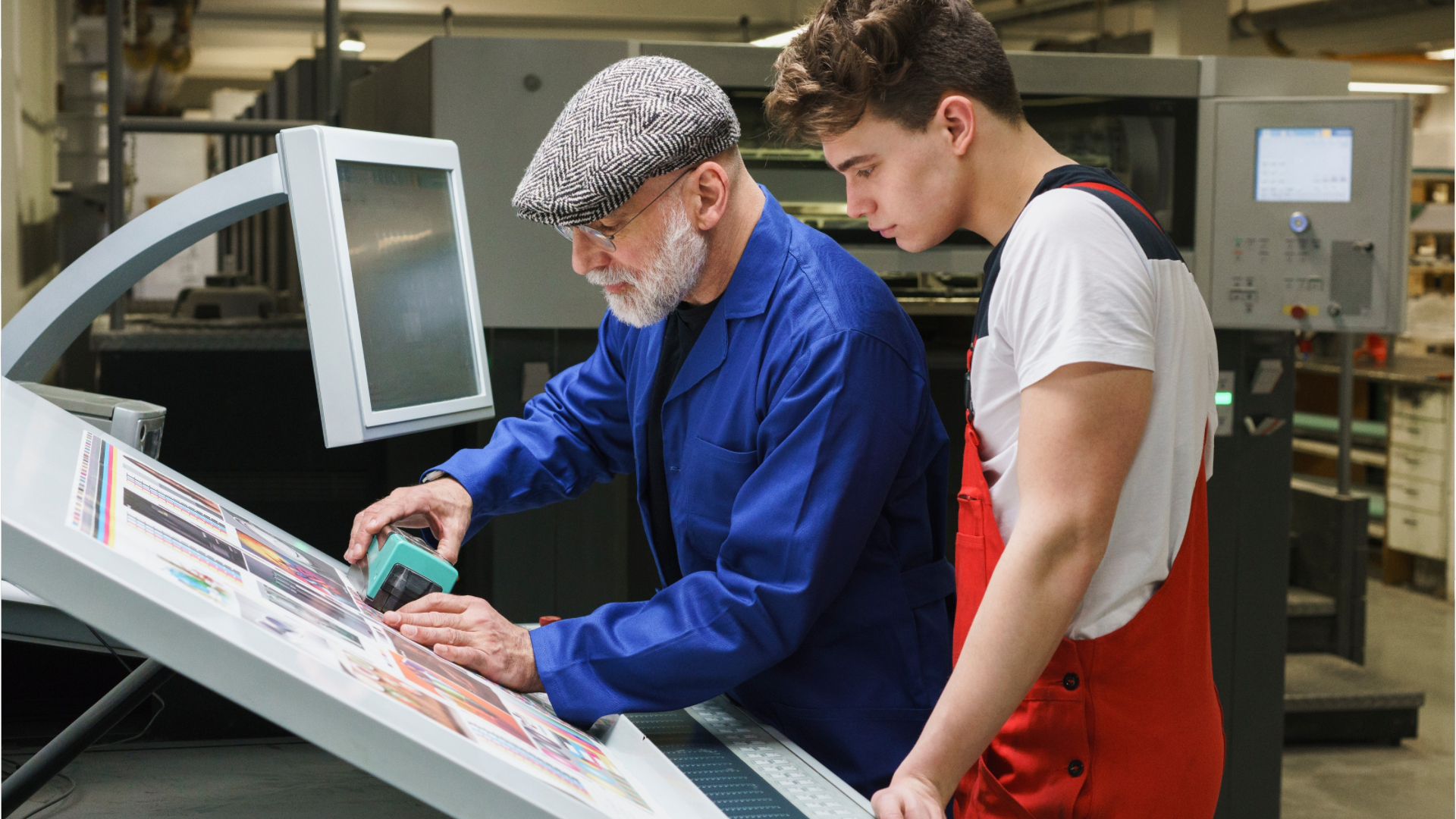In the last several years, the printing sector in London has changed a lot. This is because technology has gotten better. These changes have had a big impact on the traditional printing trends and related jobs.
As the printing industry changes, it’s important for job seekers to keep up with current trends and learn modern technology and processes. Furthermore, digital printing, 3D printing, and sustainable practices destroy traditional jobs but create new ones. To break into the industry, you must prepare with these skills.
We will discuss at the future of printing jobs in London by looking at the trends here. Future job-seekers in London may boost their chances of getting top jobs by learning about the trends today and where it’s headed in the f with well as the current affairs about printing sector.
The Future of Printing Jobs in London: Trends and Predictions
Now is a weird time for printing. The customer’s demands and tastes are changing rapidly. The leading printing companies are modernizing their business procedures and printing facilities due to such changes. And they must keep doing that as per the customer’s ever-changing wants and needs.
The year 2019 marked a watershed moment for many printing companies, as direct mail media became more popular during lockdown periods. Although printing something that people can use remains a very appealing option for many people.
In part because of Covid, several new small and large print shops have opened up around the country. There is now little to no patience for delivery services because mailing them takes only a minute. Very simply, there is less time to wait for your project to be supplied to you, given the ever-shifting demands of the market. There has also been a surge in digital printing. In fact, by 2026, it is expected to account for 21.6% of the market, up from 17.2% in 2021.
Since the late 1990s, layoffs have caused fewer and fewer people to work in printing and related service industries. A big reason why the industry went out of business was because of advances in technology. As new ways of sending and receiving information came out, people stopped using printers as much. Also, with the advance technology people are more productive and can do the same amount of work as before with more folks.
Average annual employment in the sector has fallen by around 55% since 2001. The drop has been especially rapid since the turn of the century. The industry, like the rest of manufacturing, was hard hit by the global recession after a period of relative stability between 2006 and 2008. Following this, employment levels were constant, falling gradually over the subsequent seven years. When the COVID-19 pandemic first hit, the printing industry suffered another round of job losses.
There are, however, other media that are rapidly expanding their distribution of news and information in the current era. Before the internet and e-books, it was radio and TV that successfully wooed consumers away from print media. Demand for printed materials has dropped as a result, hurting the printing industry and the jobs it supports.
However, the printing business will likely adjust to shifting customer needs and technology. These predictions will help companies succeed in the future if they follow them.
- Digital printing has grown for years and is inclined to maintain. Small and medium-sized firms will benefit from technology’s advancement and affordability. This may increase digital printing competition and innovation.
- Customers are increasingly interested in customized items. Personalized labels, packaging, and other printed items are trendy nowadays. So, printing companies offering these services may see greater demand.
- Consumers are growing more eco-conscious, which may affect the printing sector. Sustainable printing enterprises may attract more customers. This may involve employing recycled materials or developing more sustainable printing methods.
- Printing will likely integrate with other technologies as technology advances. Augmented reality can enhance printed products like packaging and marketing brochures. Integrated printing services will be in high demand.
How to Break into the Printing Industry in London: Tips for Job Seekers
You might assume it’s difficult for a newcomer to break into the printing sector. It’s not always apparent how to get started or what knowledge and abilities are necessary. You can improve your chances of breaking into the printing industry and landing top-tier printing jobs by acquiring specific credentials. We’re talking to them right now.
Although a diploma or degree in printing management, print media, print production, or digital print production is not required, it may help your application stand out.
There are still opportunities in the printing sector even if you don’t have a bachelor’s degree or a superior diploma. There are plenty of opportunities, and many firms are prepared to provide on-the-job training, such as through day-release programs or apprenticeships. An apprenticeship program is the simplest way to get a job or start working in printing.
You can gain the knowledge and experience that printing companies value most by taking on an apprenticeship position. In addition, you will earn legitimate certifications that will look great on your resume for a potential employer, expanding your career options in the printing industry.
In addition to increasing your potential for having a great career in printing, an apprenticeship can help you feel more certain in your abilities by allowing you to learn at your own pace under the guidance of an experienced teacher.
In addition, there are certain skills that printing sector firms seek when hiring new staff. Gaining the attention of future employers requires:
- Ability to prioritize work, set realistic goals, and make wise decisions under pressure are all hallmarks of a well-organized person.
- Ability to work under stress while maintaining quality and accuracy in your output.
- Initiative and the ability to think critically and solve problems in the absence of explicit instructions.
- The ability to utilize information technology is becoming important in the printing business, as it is in many others.
- Excellent verbal and written communication abilities; client-focused perspective; team player. This highlights the significance of providing first-rate service to customers.
- Ability to examine and draw reasonable inferences from numerical and verbal data using critical thinking skills.
Some Tips for Job Seekers
You can look at the tips provided by experts and elders in the printing industry to prepare yourself optimally.
- Create a good design and printing portfolio. Showcase your versatility in materials, colours, and patterns.
- Attend industry conferences and events to network with printing professionals. This can help you network, discover industry trends, and find jobs.
- Join relevant professional organizations like the BPIF and IPIA. They provide resources, training, and networking.
- Follow printing industry trends including digital printing, sustainable printing, and new materials. This can demonstrate your expertise and creativity.
- For specialized knowledge and abilities, consider a printing technology or graphic design degree or certification.
- Be eager to start at the bottom and work up. This can provide you experience and a good work ethic.
- Develop ties with printers, designers, and marketing and advertising specialists. These connections may lead to jobs and project partnerships.
- If you want to learn from the pros and get some real world experience, an internship or apprenticeship is the way to go.
Tools and Resources for Job Seekers
There are some tools and resources that you can utilize while seeking a job in the printing sector. Here are some of the tools and resources that printing industry job seekers can use:
Job Boards
Internet job boards such as Indeed, Glassdoor, and Monster frequently offer openings for positions in the printing business.
Professional Organizations
Groups for experts in a given field, for example, BPIF and IPIA both have a variety of useful resources for their members, including job postings, educational opportunities, and networking events.
Industry Publications
Graphic Arts Magazine, Printing Impressions, and Printing News are just a few of the trade journals that cover the latest developments, trends, and employment possibilities in the printing business.
LinkedIn is a great resource for people looking for work in the printing business. It’s a great resource for finding new printing related jobs, making professional connections, and joining relevant groups.
Social Media
Like LinkedIn other social media can be great place to seek job on printing sector though they are not corporate-centric like LinkedIn.
Here are a few suggestions for additional steps job seekers can take to stay informed and competitive in the job market.
- To keep up with industry changes, take courses or courses on the latest printing and design tools.
- Create a website or online portfolio to help future employers find you.
- Connect with industry people on LinkedIn, attend industry events, and join professional organizations to learn about employment openings.
- Learn new skills and try new projects. This can keep you competitive and boost your chances of getting a printing contract.
Conclusion
London printing jobs are going to change a lot in the future. It’s not only a problem in London; it’s a problem everywhere. Traditional ways of printing and the professions that go with them are becoming less common because of new technologies. However, there are a handful of exciting new benefits for the folks. There are new opportunities and occupations opening up in digital printing, 3D printing, and sustainable printing techniques.
If people make them skilled keeping in mind the changes and inventions from new technologies and practices, the job will be there for them. So, people who want to work in the printing industry need to keep up with new trends and put money into their education and skills to be competitive. By using modern technology and sustainable approaches, people can find exciting job opportunities.

Hi! I’m Jon Tabner, I am a Graphic Designer and Marketing Executive in profession. Exploring new things, innovation and designing is my passion. Now working as head of Graphic Designing & Marketing Executive team at Print In London and currently I am based in London. I love using my design knowledge to inspire small businesses to think outside the box when designing their print.

